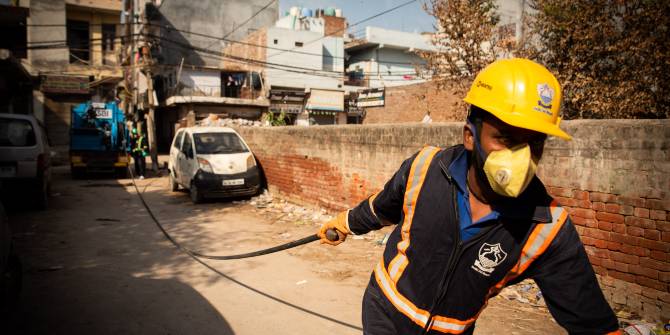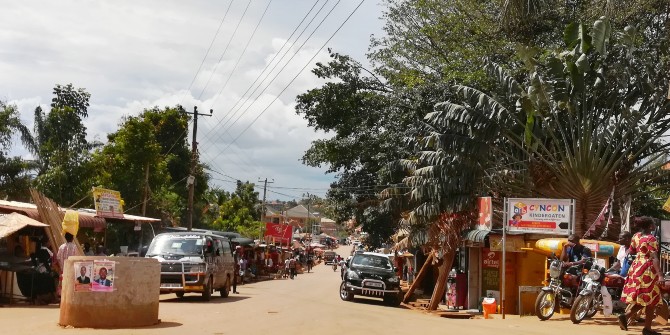The COVID-19 lockdown implemented in India is estimated to have tripled the urban unemployment rate. Most low-income urban workers will fall through the cracks of the provisions being put in place to support workers, and almost none of them has access to benefits. Swati Dhingra (LSE) argues that the self-targeting features of a universal job guarantee make it an appealing policy option to protect informal workers in urban India both now and in the longer term.
The lockdown in India due to the COVID-19 pandemic is estimated to have tripled the urban unemployment rate within three weeks. A full bounce back and business sentiment has shifted from negative to one of stark pessimism, according to the Reserve Bank of India. The government’s seemingly bold economic package does little for workers in urban areas.

The vast majority of people working in urban areas are employed informally. They have no written job contracts, no regular salaried work, and are often employed casually through job contractors, subcontractors and temp agencies. Several attempts to formalise informal work have been made and are underway. But the reality on the ground is that the majority of urban workers – 62-85% of them – have no access to benefits, which make up the flagship schemes for COVID-19 relief to workers in urban areas.
Among urban workers who are in private casual work, over 80% are in establishments that are typically not even enrolled in social security programmes like employees’ provident and state insurance funds, which are being used to provide relief to workers during the lockdown. The organised sector in India is required to provide benefits to many of the workers that they employ informally. But most low-income urban workers fall through the cracks of these provisions and almost none of them have access to benefits.
Policies to protect workers are being discussed across the world. These include immediate measures, like the United Kingdom’s payment of 80% of wages for furloughed workers who are being kept on by their employers and longer-term measures like a universal basic income, which has been gathering support from a number of academics and political figures. Many of these ideas have emerged from developed countries that have substantial state capacity and well-developed tax and benefits infrastructure in place to carry out plans broadly, quickly and over a sustained period of time.
In developing economies like India, overcoming an economic crisis is important for saving lives because economic insecurity is fundamental to the overall wellbeing of vulnerable groups. India’s premier business association, the Confederation of Indian Industries (CII), has already urged the national government to provide a fiscal stimulus of Rs.2 trillion, which could support 200 million low-income people with Rs.10,000 each.
A common feature of the majority of economic proposals being put forward is an insistence on targeted direct transfers to individuals, often administered through biometric identification-based bank accounts. In fact, the CII specifically mentions an “Aadhar-based Direct Benefit Transfer”. Restricting the discussion on longer-term measures to targeted direct bank transfers is unwarranted and hardly based on evidence. Encashing checks or targeting based on incomes may be relatively easy in developed economies like the US and the UK. But for vulnerable groups in India, access to banks (especially in the near future) and correct targeting of benefits are a perennial problem.
Targeting based on incomes sounds straightforward, but it requires governments to have deep knowledge of who is poor and vulnerable and an infrastructure to reach them on time. But detailed data are lacking. For example, just 7% of adults file taxes and available labour force statistics make it difficult to identify unemployed individuals accurately. There is now growing evidence of exclusions and omissions, and payment failures and misdirection that have resulted from the existing targeted direct bank transfer system. These failings have created severe hardship for vulnerable groups, even in normal times and in places where the system has been in place for a while (Dreze et al. 2017).
In this context, the self-targeting nature of a job guarantee programme makes it an appealing longer-term policy option to address the looming economic crisis and its impacts on those in precarious work. As early as 1989, inspired by job schemes in California, India and England, Besley and Coate (1992) favoured work over welfare payments for two reasons that are particularly relevant for urban India.
Workfare schemes, like job guarantees, are self-targeting. A needy rural household and a rural landlord both have access to work under India’s National Rural Employment Guarantee Act (NREGA), but the landlord is rarely going to take up digging wells for Rs.202 a day. A job guarantee minimises the targeting problem of who applies for income support. It gives needy households livelihood security during bad times. A second reason is that job programmes help people develop work skills and public goods, which sustain further growth.
These reasons motivated India’s NREGA to cover all rural households and the government expects to rely on it to create rural jobs once social distancing rules are relaxed. It is time to be bolder than this. A universal job guarantee needs to be on the table for discussion to cover the many workers who are in precarious work everywhere in the country.
Unfortunately, the track record of recent economic events, like demonetisation, implementation of the Goods and Services Tax and now the COVID-19 pandemic, have shown that vulnerable groups remain hard to reach. Information and infrastructure in India have not changed radically enough to warrant the complacency that direct transfers to specific households will take care of their economic insecurity. Early arguments for the value of a job guarantee are still relevant.
To understand whether job guarantees are valued by workers, the Centre for Economic Performance (CEP) at the London School of Economics conducted a large-scale survey of over 16,000 individuals in India during 2018 (Dhingra and Machin 2020).
National statistics, even in more advanced countries, have proven inadequate in recording informal workers, especially the new breed of self-employed and temporary workers who have arisen in cities outside of the organised sector. Many of these informal workers have a portfolio of short-lived, temporary and seasonal jobs that go unrecorded in national surveys.
A key finding of the CEP survey is that, on average, an urban worker is willing to take a 15% wage cut to get a guaranteed number of days of work in the year. (NREGA takes the form of a 100 days of guaranteed work for rural households).
Another finding from the survey is sobering in the light of the plight of migrants since the lockdown. Migrants in our survey – those living in a state other than their state of birth or commuting in from villages and towns into cities – were much less likely than non-migrants to be able to pay for emergency expenses. They also placed a greater value on having a job guarantee.
Most migrants in India are not eligible for targeted programmes outside of their home regions. Although a universal programme would not have overcome the immediate plight of these uncovered migrants, it is certainly fair to say that the shortcomings of targeted programmes and the safety net holes they create have not been adequately weighed in the policy discussion.
The self-targeting feature of job guarantees makes them equitable and cost-effective. A 100-day job guarantee at a daily wage of Rs.200 (similar to what’s been announced for NREGA) would cost Rs.20,000 per person.
Let’s suppose all casual workers (13% of the urban workforce of 300 million persons), irrespective of income, take up the job guarantee. To calculate how many other individuals take it up, add the 15% value that workers place on having a job guarantee and we end up with a daily value of Rs.230. In urban India, 16% of the workforce, including those who are unemployed, earn less than Rs.230 from other work and suppose all of them take up a job guarantee. From a back of the envelope calculation, an urban job guarantee would cost Rs.1.74 trillion, or 0.8% of India’s annual GDP. This is easily within the reach of a nation aspiring to a $5 trillion economy.
Of course, many including the government’s expert panel on minimum wages, would think Rs.200 is obscenely low. At Rs.400 a day, the estimated cost of providing a 100-day job guarantee would be Rs.6.6 trillion. The take-up rates assumed here are very high to provide upper limit estimates. In reality, costs are likely to be much lower, because the take-up rates here include government workers and business owners, who place much lower values on a job guarantee. Importantly, these costs do not net out potential benefits from skills for young urban workers, 93% of who have no formal vocational or on-the job training. A job guarantee might lift some of their despondency, as documented for young UK workers during the New Deals of the late 1990s (Layard 2001).
As a pioneer of the world’s largest jobs programme, India has chosen to undermine its appeal even though evidence is already suggesting increases in labour attendance since opening up of NREGA works. At a time of severe economic insecurity, a pledge, not even an actual outlay, of 1-3% of GDP is a minuscule sum to restore a life of dignity to those who have often fallen through the cracks of the nation’s safety nets.
This is not the time for self-professed ‘technophiles’ to cling dogmatically to the libertarian ambitions of targeted biometrically-linked transfers as an end in itself. Old ideas of job guarantees have value in today’s difficult economic times.
Offline references
Besley, T, and S Coate (1992), “Workfare versus Welfare: Incentive Arguments for Work Requirements in Poverty-Alleviation Programs”, American Economic Review 82(1): 249-261, 1992.
Dhingra, S and S Machin (2020), “The Value of a Job Guarantee to Workers”, Working Paper.
Drèze, J, N Khalid, R Khera and A Somanchi (2017), “Aadhaar and Food Security in Jharkhand Pain without Gain?”, Special Article, Economic & Political Weekly LII(50).
Layard, R (2001), “Welfare to work and the new deal”, Occasional paper CEPOP15, Centre for Economic Performance, London School of Economics and Political Science.
Author’s note
The figures cited here are based on data from the Periodic Labour Force Survey 2017-18 and a new CEP survey of informal workers in India, which was conducted in 2018 (Dhingra and Machin 2020).
This post represents the views of the author and not those of the COVID-19 blog, nor LSE. It first appeared at Vox.EU.
Swati Dhingra is an Associate Professor of Economics at LSE.





1 Comments